Table of Contents |
Spain and France are the two modern-day countries in which the ancient cave paintings discussed in this lesson reside. These cave paintings are from the time period ranging from about 33,000 BCE to about 12,000 BCE.
One of the cave paintings being explored in this lesson is found in the cave of Altamira, which is located in the very north of Spain, indicated here in the map below.
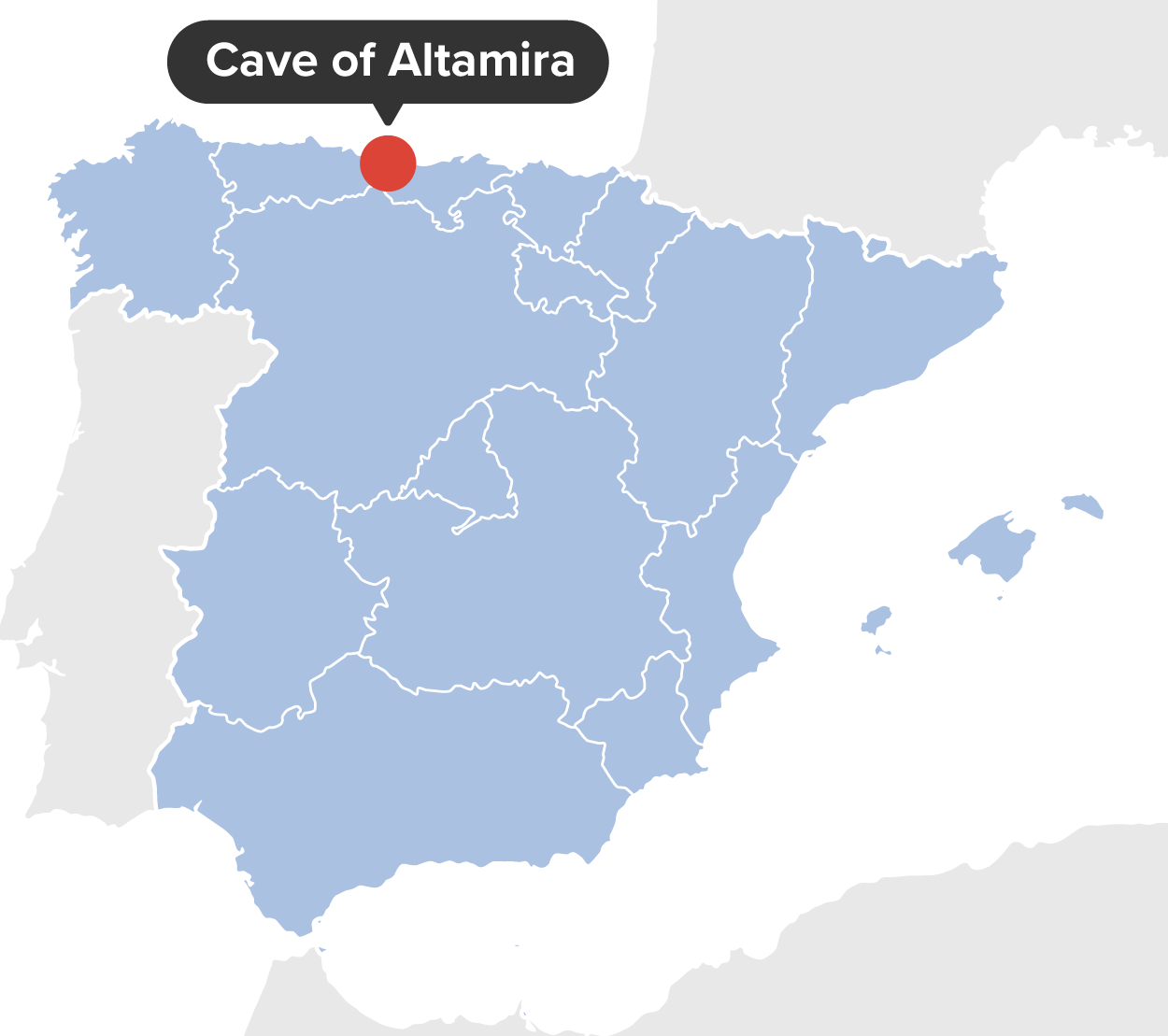
The next map highlights the approximate locations of the cave paintings in France covered in this lesson. This is a map of modern-day France. On the right is Chauvet Cave. The second cave, at the bottom, is Pech Merle. The third is Lascaux, which was the subject of filmmaker Werner Herzog's 2010 movie, Cave of Forgotten Dreams.

Artists use perspective to depict images in specific ways that we see in cave paintings. Optical perspective is when an object is depicted from only one side. Twisted perspective depicts an object from two different perspectives. This technique is common in Mesopotamian art.
EXAMPLE
The head might be facing forward, and the body might be a side profile.In contrast, descriptive point of view is an attempt at explaining something in three dimensions. This type of perspective uses techniques including overlapping and foreshortening. Foreshortening is depicting objects that are further back a little bit shorter or smaller.
Take note of the similarities and differences in the following three examples of perspective.
First, an example of optical perspective is shown below. This image is only seen from one side.
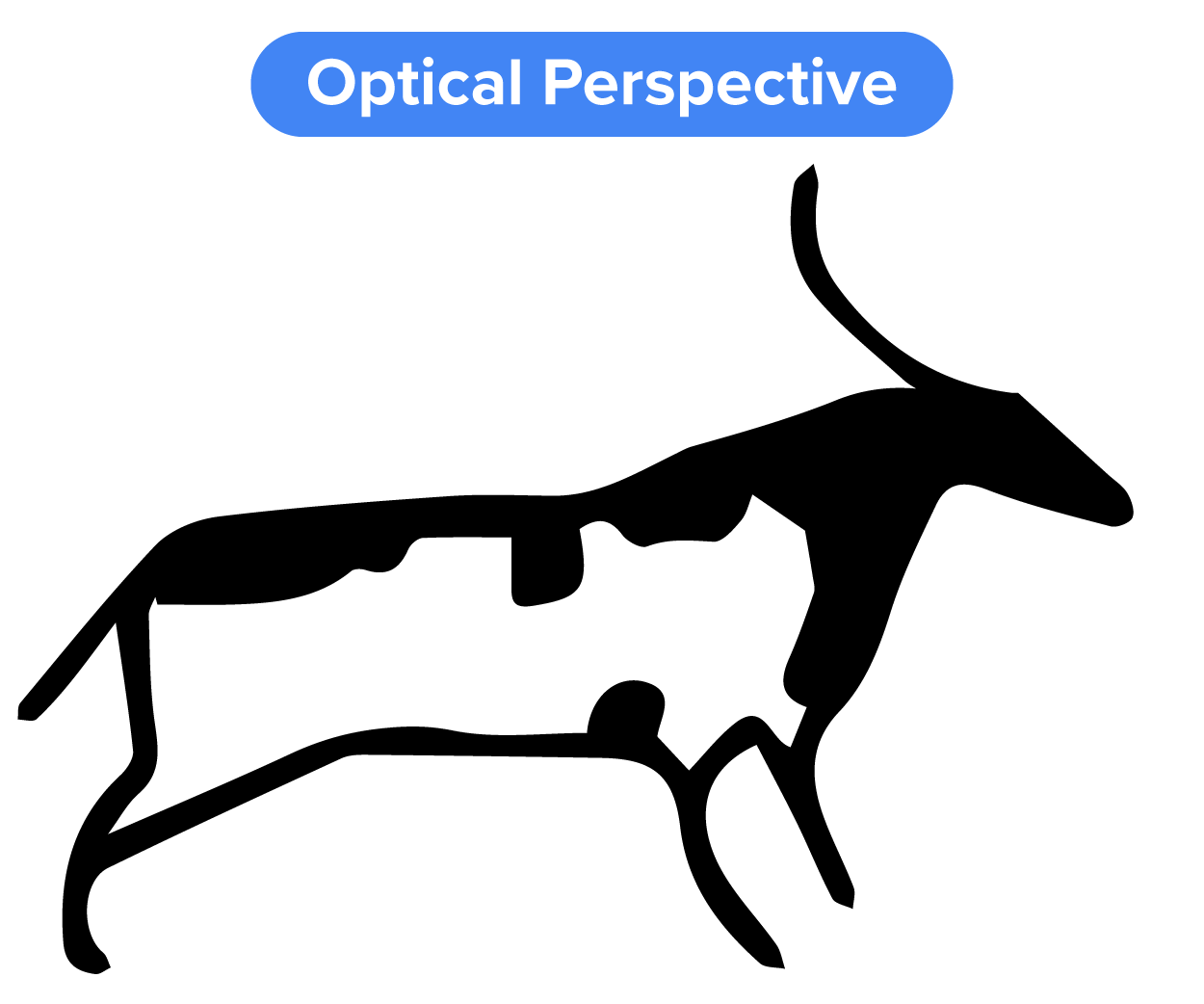
Next is an example of twisted perspective. Notice how you can now see the full head since it is facing forward. The body, however, is still seen only from the side.

Finally, below is an example of descriptive point of view. There is an attempt to depict the image in three dimensions. Remember, foreshortening is when objects that are further back are depicted as shorter or smaller. This can be seen in the legs on the bottom, the nostril, the eyeball, and the ear on the left side.
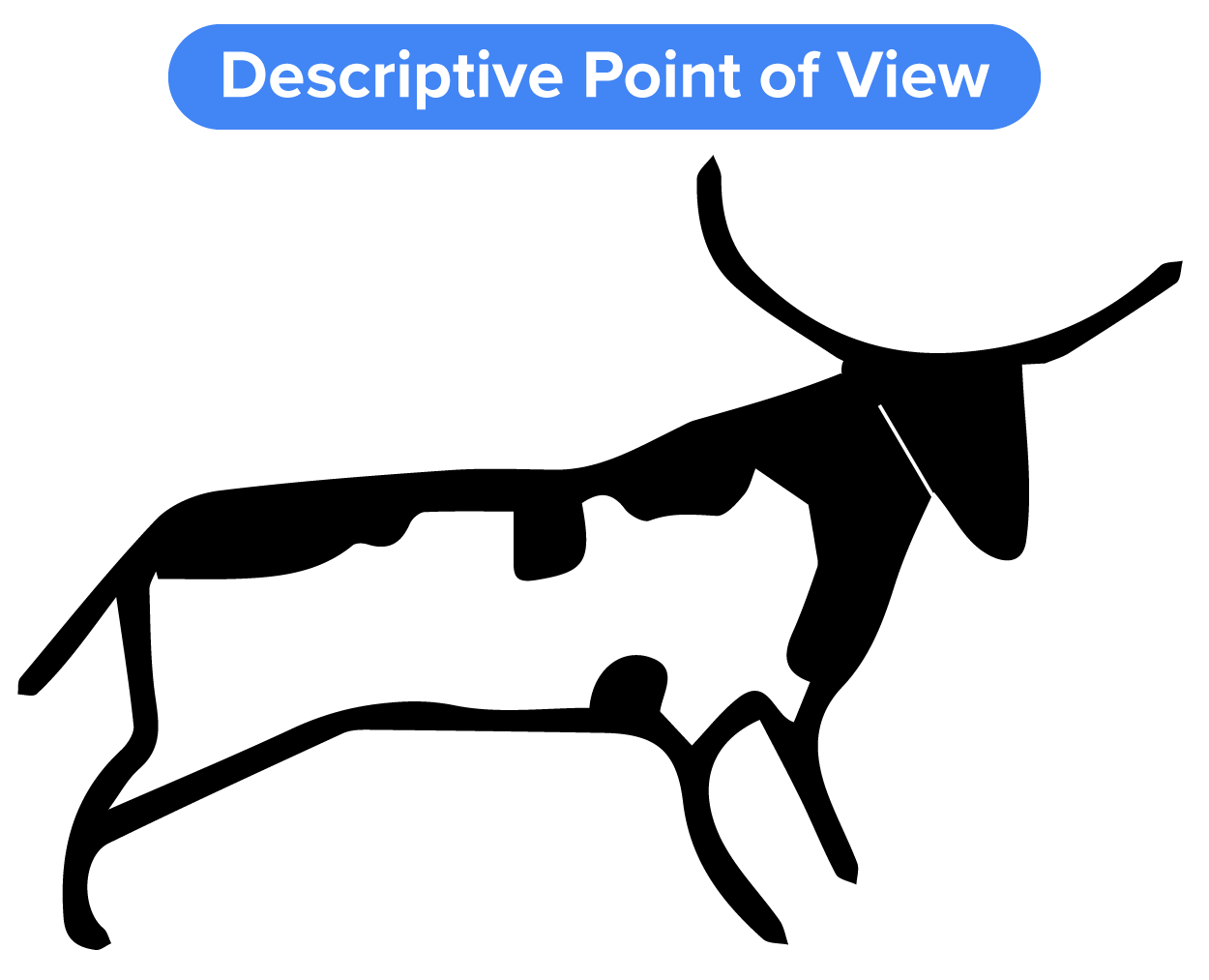
Even as far back as this time period, ancient artists had a sophisticated way of depicting realistic imagery. An awareness of artistic perspective is demonstrated in the use of various perspectives, particularly the use of the descriptive point of view.
Judging by what materials might have been available during this era, pigments would have been limited in color.
Take a look at the handprint below. This is thought by scholars to have been created using the technique described above.
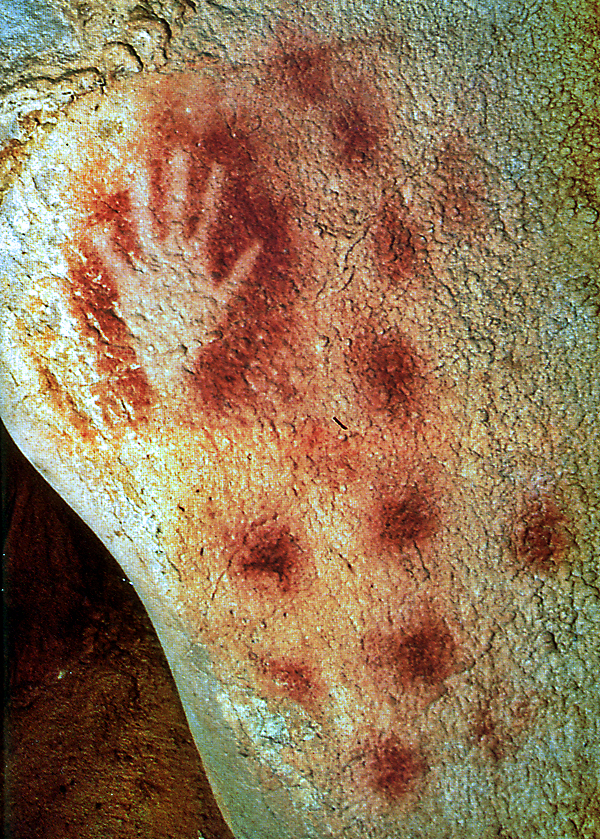
Handprint, from the Pech Merle cave
Lot Department, Midi-Pyrénées, France
25,000 years BP
Red ochre
Let's look at the following pieces of artwork:

The second work of art, shown below, is also from Lascaux and is known as The Bird-Headed Man. It’s possibly a hunter with a bison and shows an overly simplified depiction of a human lying down next to a much more detailed image of a bison portrayed in a twisted perspective. It also shows the disembowelment of the animal. This is different from other paintings at Lascaux in how it seems to be telling a story. Whether it is a scene from real life, a hunting expedition, a story, or the vision of a shaman is left to debate.
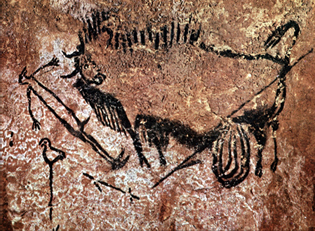
Bird Headed Man and Bison
Lascaux, Montignac, France
50,000 and 12,000 BP, Upper Paleolithic
This next work of art, shown below, comes from the Pech Merle cave in France and depicts two spotted horses from about 25,000 BCE, with some hand images added about 10,000 years later. The interesting thing about this painting is how the application of the pigment strongly suggests the employment of some type of tool, such as a hair paintbrush, or the primitive airbrush technique described before. Examples such as this help support the hypothesis that prehistoric humans were much more sophisticated than originally thought.
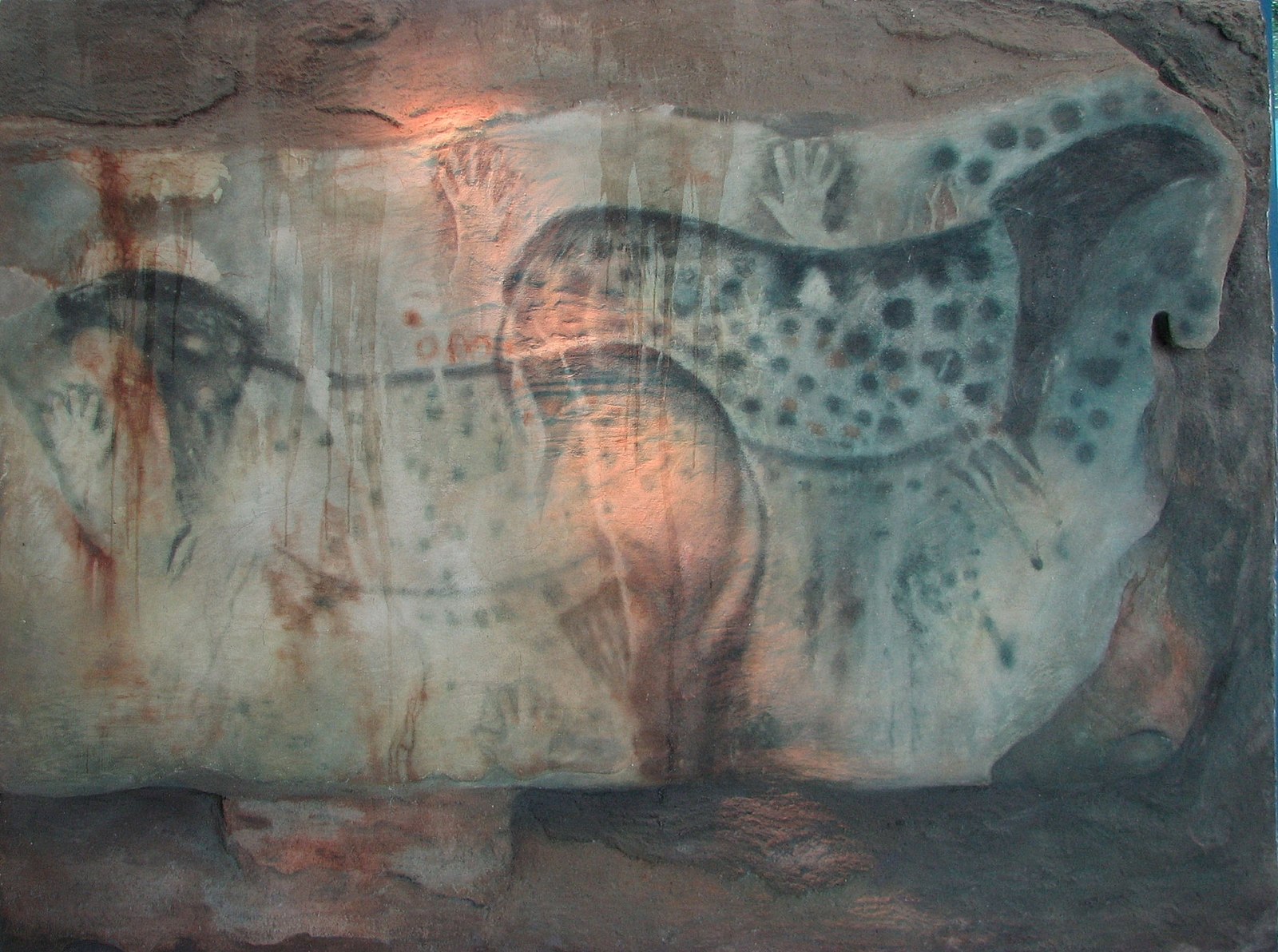
Spotted Horses With Hands, from the Pech Merle cave
Lot Department, Midi-Pyrénées, France
25,000 years BP
This final work of art is actually the oldest image examined in this lesson. It comes from the Chauvet Cave in France and dates to about 32,000 BCE. This is a great example of the use of descriptive point of view in rendering the images. The other interesting thing is in the depiction of the rhinoceros, an animal we identify with Africa today, showing up in France.
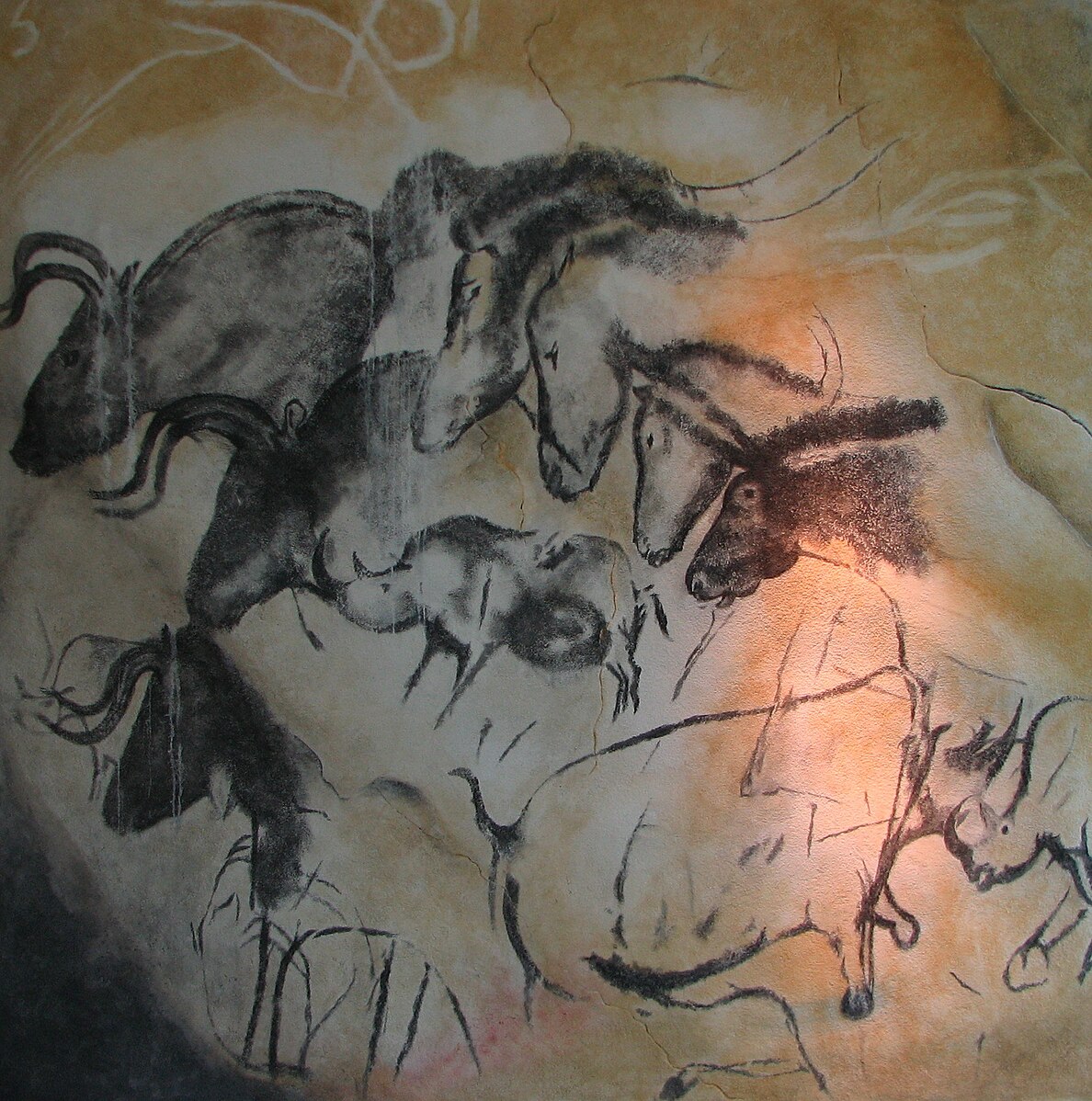
Fighting Rhino and Horses from the Chauvet cave
Ardèche, France
32,000 to 30,000 BP
Cave paintings found in Spain were first discovered in 1897, by accident, by a little girl from Altamira, Spain. The cave paintings here introduce many questions, particularly about their purpose.
The cave paintings found in this area of Spain were in small, difficult-to-access areas. This has led many scholars to believe that they were not intended to be viewed by the majority of people, given their limited access. So, the question raised is if they were only intended to be viewed by certain people, who would those people be, and what purpose would the paintings serve?
Scholars have suggested many theories regarding the purpose of these images. Some believe they were painted just for art’s sake. Others believe they may have been a part of initiation rites, meant to teach individuals about the behavior of animals, or possibly for hunting magic, which was a way of ensuring successful hunts. These hunts were essential to the survival of these nomadic people. Others have suggested that the paintings are related to shamanism, specifically that they are the representations of visions observed in an altered state of consciousness. Regardless, they were undoubtedly important, as people kept returning to them for thousands and thousands of years.
Below is an image from the cave of Altamira in Spain. It depicts a bison, using the descriptive point of view, and dates from about 12,000 BCE.
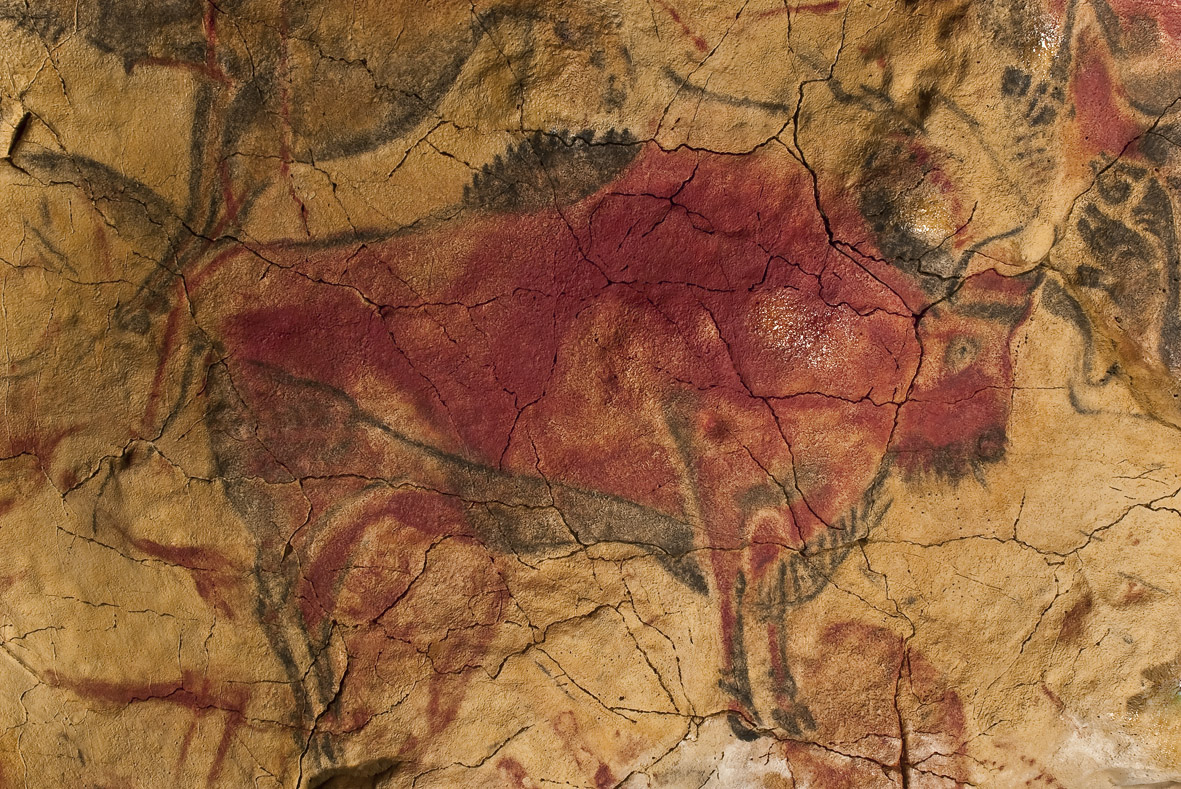
Magdalenian polychrome bison from the cave of Altamira
Santillana del Mar, Cantabria, Spain
43,000 to 26,000 BP
The term “rock art” refers generally to any type of art made on stone, including paintings, petroglyphs, carvings, and other forms of art. It might involve images painted deep inside caves, or paintings or relief carvings on surfaces that are more exposed. Rock art is one of the oldest forms of art ever produced and, in some cases, predates the cave paintings at Altamira and Lascaux.
EXAMPLE
The oldest rock paintings that we know of are located on the island of Sulawesi in Indonesia and depict warty pigs. They are estimated to be approximately 45,000 years old.Some rock paintings in Australia are so old that the pigment used to create the image has fused with the rock. Some scholars have identified animals in Australian rock art that went extinct tens of thousands of years ago, so they argue that those images date to a time when those animals still existed. There is a lot of disagreement surrounding this, and other scholars argue that the animals have been misidentified.

Gwion Gwion rock paintings
North-west Kimberley region of Western Australia
17,000 years old
One of the biggest challenges with rock art is how to interpret it. With the complete lack of written records, it is easy to speculate about its potential function. One idea is that images of animals may have served as votive figures and that people produced them as a way of asking forgiveness for hunting them. These carvings are from Niger and depict two giraffes with a high degree of skill. One giraffe is male and the other is female. These are examples of petroglyphs, or images made by carving lines into solid rock. Some petroglyphs also involve filling in the incised lines with pigment, so that the image stands out more.

Dabous Giraffes
Aïr Mountains, near Agadez, Niger
10,000–4,500 BP, Neolithic
Sandstone
Another interpretation of images of animals in rock art is that they either represent deities and figures from local mythology, or they represent completely abstract concepts and should not be taken at face value.

Depiction of eland from the Eland Cave
Drakensberg, South Africa
533 BP and 453 BP
Rock art exists on all continents except Antarctica. There are over 100,000 examples of rock art in Africa alone. A project sponsored by the British Museum involves photographing and preserving images of rock art in Africa for future generations. One of the aspects that unites much of this art is its fragility and susceptibility to vandalism, erosion, and destruction over time. Early attempts to preserve rock art involved removing it from its original location, or dampening the surface to bring out the image, causing damage that could not be fixed. Today, we recognize that one of the best things to do with rock art is leave it alone.
Source: THIS TUTORIAL WAS AUTHORED BY IAN MCCONNELL AND ERIN ALDANA FOR SOPHIA LEARNING. PLEASE SEE OUR TERMS OF USE.